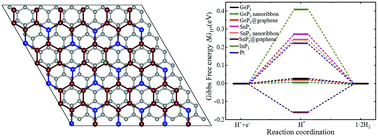Monolayer triphosphates MP3 (M = Sn, Ge) with excellent basal catalytic activity for hydrogen evolution reaction†
Abstract
Atomically thin two-dimensional (2D) materials have received intense research interest due to their novel properties and promising applications in nanodevices. By using density functional theory (DFT) calculations, we investigate catalytic activities of several newly predicted two-dimensional (2D) triphosphides GeP3, SnP3 and InP3 monolayers for hydrogen evolution reaction (HER). The calculation results show that GeP3 and SnP3 monolayers are active catalysts for HER with suitable free energy of hydrogen adsorption in the basal plane. In particular, the Gibbs free energy of hydrogen adsorption (ΔGH*) of GeP3 is 0.024 eV, a value even more favorable compared to the precious-group-metal (PGM) catalyst Pt. Moreover, the 2D GeP3 and SnP3 are intrinsically compatible with the graphene substrate so that the HER performance can be improved via building a hybrid multilayer with graphene sheet. The charge transfer from GeP3 or SnP3 to graphene, estimated to be 0.1278e or 0.2157e, can significantly enhance the electric conductivity and promote the electrocatalytic activity. Although the electronic band structure of GeP3 and SnP3 can be tuned by external strain, we find that the HER performance of GeP3 and SnP3 monolayer is actually insensitive to the external strain, a feature desirable for the catalytic application. The desirable properties for HER with nearly zero Gibbs free energy render 2D GeP3 and SnP3 promising candidates for future application in electrocatalysis.



 Please wait while we load your content...
Please wait while we load your content...